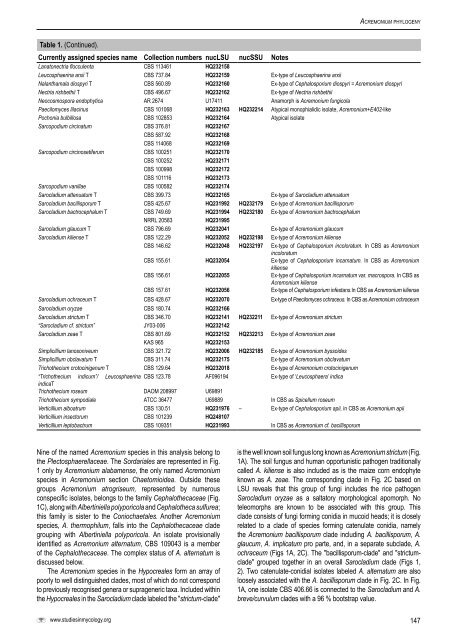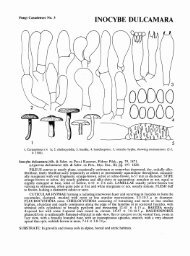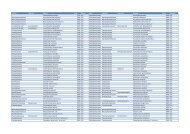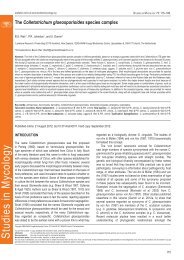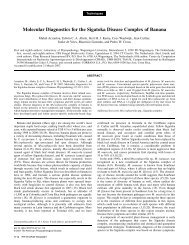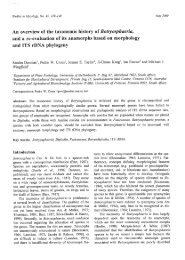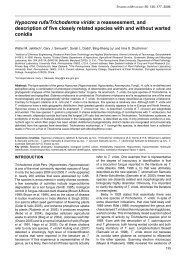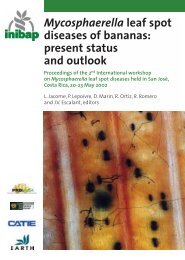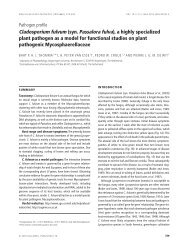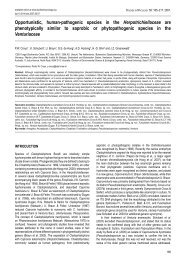Acremonium phylogenetic overview and revision of ... - CBS - KNAW
Acremonium phylogenetic overview and revision of ... - CBS - KNAW
Acremonium phylogenetic overview and revision of ... - CBS - KNAW
Create successful ePaper yourself
Turn your PDF publications into a flip-book with our unique Google optimized e-Paper software.
www.studiesinmycology.org<br />
acremonium phylogeny<br />
Table 1. (Continued).<br />
Currently assigned species name Collection numbers nuclsU nucssU Notes<br />
Lanatonectria flocculenta <strong>CBS</strong> 113461 hQ232158<br />
Leucosphaerina arxii T <strong>CBS</strong> 737.84 hQ232159 Ex-type <strong>of</strong> Leucosphaerina arxii<br />
Nalanthamala diospyri T <strong>CBS</strong> 560.89 hQ232160 Ex-type <strong>of</strong> Cephalosporium diospyri = <strong>Acremonium</strong> diospyri<br />
Nectria rishbethii T <strong>CBS</strong> 496.67 hQ232162 Ex-type <strong>of</strong> Nectria rishbethii<br />
Neocosmospora endophytica AR 2674 U17411 Anamorph is <strong>Acremonium</strong> fungicola<br />
Paecilomyces lilacinus <strong>CBS</strong> 101068 hQ232163 hQ232214 Atypical monophialidic isolate, <strong>Acremonium</strong>+E402-like<br />
Pochonia bulbillosa <strong>CBS</strong> 102853 hQ232164 Atypical isolate<br />
Sarcopodium circinatum <strong>CBS</strong> 376.81 hQ232167<br />
<strong>CBS</strong> 587.92 hQ232168<br />
<strong>CBS</strong> 114068 hQ232169<br />
Sarcopodium circinosetiferum <strong>CBS</strong> 100251 hQ232170<br />
<strong>CBS</strong> 100252 hQ232171<br />
<strong>CBS</strong> 100998 hQ232172<br />
<strong>CBS</strong> 101116 hQ232173<br />
Sarcopodium vanillae <strong>CBS</strong> 100582 hQ232174<br />
Sarocladium attenuatum T <strong>CBS</strong> 399.73 hQ232165 Ex-type <strong>of</strong> Sarocladium attenuatum<br />
Sarocladium bacillisporum T <strong>CBS</strong> 425.67 hQ231992 hQ232179 Ex-type <strong>of</strong> <strong>Acremonium</strong> bacillisporum<br />
Sarocladium bactrocephalum T <strong>CBS</strong> 749.69 hQ231994 hQ232180 Ex-type <strong>of</strong> <strong>Acremonium</strong> bactrocephalum<br />
NRRL 20583 hQ231995<br />
Sarocladium glaucum T <strong>CBS</strong> 796.69 hQ232041 Ex-type <strong>of</strong> <strong>Acremonium</strong> glaucum<br />
Sarocladium kiliense T <strong>CBS</strong> 122.29 hQ232052 hQ232198 Ex-type <strong>of</strong> <strong>Acremonium</strong> kiliense<br />
<strong>CBS</strong> 146.62 hQ232048 hQ232197 Ex-type <strong>of</strong> Cephalosporium incoloratum. In <strong>CBS</strong> as <strong>Acremonium</strong><br />
incoloratum<br />
<strong>CBS</strong> 155.61 hQ232054 Ex-type <strong>of</strong> Cephalosporium incarnatum. In <strong>CBS</strong> as <strong>Acremonium</strong><br />
kiliense<br />
<strong>CBS</strong> 156.61 hQ232055 Ex-type <strong>of</strong> Cephalosporium incarnatum var. macrospora. In <strong>CBS</strong> as<br />
<strong>Acremonium</strong> kiliense<br />
<strong>CBS</strong> 157.61 hQ232056 Ex-type <strong>of</strong> Cephalosporium infestans.In <strong>CBS</strong> as <strong>Acremonium</strong> kiliense<br />
Sarocladium ochraceum T <strong>CBS</strong> 428.67 hQ232070 Ex-type <strong>of</strong> Paecilomyces ochraceus. In <strong>CBS</strong> as <strong>Acremonium</strong> ochraceum<br />
Sarocladium oryzae <strong>CBS</strong> 180.74 hQ232166<br />
Sarocladium strictum T <strong>CBS</strong> 346.70 hQ232141 hQ232211 Ex-type <strong>of</strong> <strong>Acremonium</strong> strictum<br />
“Sarocladium cf. strictum” JY03-006 hQ232142<br />
Sarocladium zeae T <strong>CBS</strong> 801.69 hQ232152 hQ232213 Ex-type <strong>of</strong> <strong>Acremonium</strong> zeae<br />
KAS 965 hQ232153<br />
Simplicillium lanosoniveum <strong>CBS</strong> 321.72 hQ232006 hQ232185 Ex-type <strong>of</strong> <strong>Acremonium</strong> byssoides<br />
Simplicillium obclavatum T <strong>CBS</strong> 311.74 hQ232175 Ex-type <strong>of</strong> <strong>Acremonium</strong> obclavatum<br />
Trichothecium crotocinigenum T <strong>CBS</strong> 129.64 hQ232018 Ex-type <strong>of</strong> <strong>Acremonium</strong> crotocinigenum<br />
“Trichothecium<br />
indicaT<br />
indicum”/ Leucosphaerina <strong>CBS</strong> 123.78 AF096194 Ex-type <strong>of</strong> ‘Leucosphaera’ indica<br />
Trichothecium roseum DAOM 208997 U69891<br />
Trichothecium sympodiale ATCC 36477 U69889 In <strong>CBS</strong> as Spicellum roseum<br />
Verticillium alboatrum <strong>CBS</strong> 130.51 hQ231976 – Ex-type <strong>of</strong> Cephalosporium apii, in <strong>CBS</strong> as <strong>Acremonium</strong> apii<br />
Verticillium insectorum <strong>CBS</strong> 101239 hQ248107<br />
Verticillium leptobactrum <strong>CBS</strong> 109351 hQ231993 In <strong>CBS</strong> as <strong>Acremonium</strong> cf. bacillisporum<br />
Nine <strong>of</strong> the named <strong>Acremonium</strong> species in this analysis belong to<br />
the Plectosphaerellaceae. The Sordariales are represented in Fig.<br />
1 only by <strong>Acremonium</strong> alabamense, the only named <strong>Acremonium</strong><br />
species in <strong>Acremonium</strong> section Chaetomioidea. Outside these<br />
groups <strong>Acremonium</strong> atrogriseum, represented by numerous<br />
conspecific isolates, belongs to the family Cephalothecaceae (Fig.<br />
1C), along with Albertiniella polyporicola <strong>and</strong> Cephalotheca sulfurea;<br />
this family is sister to the Coniochaetales. Another <strong>Acremonium</strong><br />
species, A. thermophilum, falls into the Cephalothecaceae clade<br />
grouping with Albertiniella polyporicola. An isolate provisionally<br />
identified as <strong>Acremonium</strong> alternatum, <strong>CBS</strong> 109043 is a member<br />
<strong>of</strong> the Cephalothecaceae. The complex status <strong>of</strong> A. alternatum is<br />
discussed below.<br />
The <strong>Acremonium</strong> species in the Hypocreales form an array <strong>of</strong><br />
poorly to well distinguished clades, most <strong>of</strong> which do not correspond<br />
to previously recognised genera or suprageneric taxa. Included within<br />
the Hypocreales in the Sarocladium clade labeled the "strictum-clade"<br />
is the well known soil fungus long known as <strong>Acremonium</strong> strictum (Fig.<br />
1A). The soil fungus <strong>and</strong> human opportunistic pathogen traditionally<br />
called A. kiliense is also included as is the maize corn endophyte<br />
known as A. zeae. The corresponding clade in Fig. 2C based on<br />
LSU reveals that this group <strong>of</strong> fungi includes the rice pathogen<br />
Sarocladium oryzae as a saltatory morphological apomorph. No<br />
teleomorphs are known to be associated with this group. This<br />
clade consists <strong>of</strong> fungi forming conidia in mucoid heads; it is closely<br />
related to a clade <strong>of</strong> species forming catenulate conidia, namely<br />
the <strong>Acremonium</strong> bacillisporum clade including A. bacillisporum, A.<br />
glaucum, A. implicatum pro parte, <strong>and</strong>, in a separate subclade, A.<br />
ochraceum (Figs 1A, 2C). The "bacillisporum-clade" <strong>and</strong> "strictumclade"<br />
grouped together in an overall Sarocladium clade (Figs 1,<br />
2). Two catenulate-conidial isolates labeled A. alternatum are also<br />
loosely associated with the A. bacillisporum clade in Fig. 2C. In Fig.<br />
1A, one isolate <strong>CBS</strong> 406.66 is connected to the Sarocladium <strong>and</strong> A.<br />
breve/curvulum clades with a 96 % bootstrap value.<br />
147


